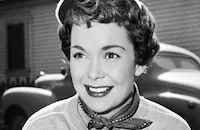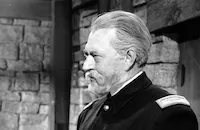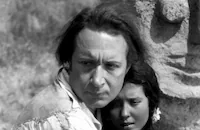The Story of Will Rogers

Brief Synopsis
Cast & Crew
Michael Curtiz
Will Rogers Jr.
Jane Wyman
Carl Benton Reid
Eve Miller
James Gleason
Film Details
Technical Specs

Synopsis
In 1900, in Oolagah, Oklahoma Indian Territory, congressmen are meeting at the house of Clem Rogers, a prominent citizen of Oklahoma and the Cherokee nation, to decide on Oklahoma statehood. Meanwhile, Betty Blake meets Will Rogers, a cowpoke returning home after two years of drifting, while she is helping her brother-in-law, station master Dave Marshall, at the train station. Betty ignores Will's friendly advances, but later learns that he is the son of Clem, who is anxious that Will take his place in the community. Clem wants Will to run their ranch, but Will is happiest meeting people and doing rope tricks, and his management style is too easygoing for Clem. Two weeks later, Betty sells Will and his friend, Dusty Donavon, two one-way tickets out of town. Through postcards that Will sends her, Betty learns that Will and Dusty sign up with a Wild West Show in South America and make a worldwide tour. When the troupe performs at the 1904 St. Louis World's Fair, Betty attends, and after the show, Will proposes to her. Although Will has talked of settling down, Betty learns on a train to Niagara Falls that both Dusty and Will's horses are accompanying them, as Will has signed on with a traveling show to finance their honeymoon. Almost one thousand performances later, Will and the pregnant Betty are planning to return to Oolagah, when Will is written up in a newspaper for lassoing a dangerous bull that got loose during a performance at New York City's Madison Square Garden. Seeing the article, Bert Lynn, a theatrical agent, offers Will a job at Oscar Hammerstein's Victoria Theater on Times Square, but Will's rope tricks, performed astride his horse, do not transfer well to vaudeville, and his act is soon canceled. After six months of unemployment and with the baby almost due, Will is offered a job at a Brooklyn theater as a last-minute fill-in performer, but Dusty and the horse are delayed, so Will begins his act alone. As he fumbles with his rope and chatters nervously, the audience finds Will's self-effacing, down-home presence appealing, and a new comedy act is born that night, as well as his first child. Soon he is headlining with Eddie Cantor at the Ziegfeld Follies, where he adds humorous political commentary to his act, poking fun at all sides of an issue. Believing that Will's morale-building humor expresses the heart of the American people, President Woodrow Wilson urges Will to write, but Will is uncomfortable being taken seriously. A few years later, Will buys a ranch for Betty and their three children in Santa Monica, California, and works in films. Clem shows up at the ranch, urging Will to create more than pie-in-the-face comedies, and even Betty urges Will to use his influence and humor responsibly. After meeting Wiley Post, an airplane pilot and fellow Cherokee, Will learns to fly and becomes a supporter of General Billy Mitchell's campaign to develop aviation for national defense. When Mitchell is charged with insubordination, Will begins a public speaking tour in support of the general that makes people laugh, as well as think. Will also begins writing a syndicated newspaper column and later, makes a European tour, finding himself welcomed by heads of state and the common people. When he returns, the United States is hard hit by the Depression, and Will is troubled to see his childhood neighbors and friends leave Oolagah to find work in the cities. After getting financial support from John D. Rockefeller and Henry Ford, Will gathers celebrities such as Fanny Brice, Marilyn Miller, Al Jolson and Eddie Cantor to throw "monster benefit" relief performances all over the country. For months, working long hours, Will flies across the country to build morale and make money for those in distress, with Wiley as his pilot. When election time rolls around, both Democratic and Republican parties adopt a relief platform, and at the Democratic National Convention, Will is nominated as a "favorite son." During his speech in support of Franklin D. Roosevelt, Will, who is honored to be "accepted by the people he comes from," tells the crowd, "I never met a man I didn't like." Witnessing the event, Clem, an Oklahoma senator, finally realizes that Will's gift to uplift and teach using humor is an important accomplishment. Later, Betty watches Will take off with Wiley for Alaska to back an appropriation bill for Alaskan defense, and has an ominous premonition, as Will has Wiley circle the plane to wave one last goodbye.

Director

Michael Curtiz
Cast
Will Rogers Jr.

Jane Wyman

Carl Benton Reid

Eve Miller

James Gleason

Slim Pickens
Noah Beery Jr.

Mary Wickes

Steve Brodie
Pinky Tomlin

Margaret Field

Eddie Cantor
Brian Daly
Jay Silverheels
Richard Kean
Earl Lee
William Forrest
Dave Butler
Virgil "slats" Taylor
Robert Scott Correll
Carol Ann Gainey
Michael Gainey
Carol Nugent
Jack Burnette
Morgan Brown
Ralph Moody
Joe Haworth

Jack Mower
Eddie Marr
Paul Mcwilliam
Madge Journeay
Millie Carroll

Bill Walker
Will Morrisey
Jack Harris
Rod Rogers
Forrest Taylor
Dub Taylor
Gayne Whitman
Charles Wagenheim
Olan Soule
John Close
Norman Phillips
Charles Kane
James Dodd
John Hedloe
Sam Mckim
Michael Pierce
Todd Karnes
Richard Clark
Howard Hagen
Danny Jackson

John Wood
Angie O. Poulos
Molly Glessing
Alfred Meissner
Fern Barry
Sheila Hayward
Christine Vaught
Leo Curley
Marshall Bradford

Monte Blue
Bob Rose
Guy Wilkerson
Denver Dixon
Linda Ware
Crew
Milo Anderson
Robert Arthur
Gordon Bau
Folmar Blangsted
Edward Carrere
Wilfrid M. Cline
Sid Cutner
Frank Davis
David C. Gardner
Oren Haglund
George James Hopkins
Mitchell G. Kovaleski
Charles Lang
John C. Moffitt
Montie Montana
Ben Pitti
Herbert "limey" Plews
Stanley Roberts
Sherry Shourds
Leo Shuken
Norman Stuart
Victor Young

Videos
Movie Clip
Hosted Intro
Film Details
Technical Specs

Articles
The Story Of Will Rogers
By Richard Harland Smith

The Story Of Will Rogers
Quotes
Trivia
Notes
The working title of the film was The Will Rogers Story. The opening title card reads: "The Story of Will Rogers as told by His Wife." The film opens with shots of the many memorials built to honor Will Rogers, and a voice-over narration comments on Rogers' status as a "folk hero." Voice-over narration by Jane Wyman as "Mrs. Will Rogers" is heard intermittently throughout the film.
As depicted in the film, the cowboy-philosopher Will Rogers was born in Oolagah, OK, near present-day Claremore, on November 4, 1879. His mother and father, a wealthy rancher and banker, were both part Cherokee. Rogers was a cowboy in the Texas Panhandle, then journeyed to Argentina and on to South Africa. Calling himself "The Cherokee Kid," he toured the world with "Texas Jack's Wild West Circus" as a rope-twirling cowboy, and later performed at the 1904 St. Louis Exposition, and in 1905, at Madison Square Garden in New York. After adding jokes and political humor to his act, Rogers performed in several Broadway musicals, and from 1916 to 1918, starred in the Ziegfeld Follies.
Rogers made his first screen appearance in the 1918 Rex Beach Pictures production Laughing Bill Hyde, playing the title role (see entry in AFI Catalog of Feature Films, 1911-20). Rogers moved to Southern California with his wife Betty and their children, continued to star in films and became the top box office star in the world. During this time he was also elected the first honorary mayor of Beverly Hills. In 1922, he returned to New York to perform again in the Ziegfeld Follies and in 1926 began writing a weekly syndicated column for the New York Times. Also in 1926, he toured Europe and the Soviet Union, and after his introduction to air travel, flew around South America and the Far East in the early 1930s.
Fox Film Corp.'s 1935 Steamboat Round the Bend, directed by John Ford and co-starring Anne Shirley and Irvin S. Cobb, was the last film Rogers made, although two other films were released later. As implied in The Story of Will Rogers, Rogers and his pilot, Wiley Post, died in an airplane accident near Point Barrow, AK on August 15, 1935. For more information about Steamboat Round the Bend and the impact of Rogers' death on the entertainment community, see the entry for the film in AFI Catalog of Feature Films, 1931-40.
Betty Blake Rogers wrote the 1940 Saturday Evening Post serial on which the film is based, and according to a May 1952 Los Angeles Times interview with Will Rogers, Jr., she and Will, Jr. interested Warner Bros. in taking an option on the idea in 1941, three years before she died. Will, Jr. stated that he was tested for the role of his father, as were several Hollywood actors, including Spencer Tracy and Bing Crosby, but, according to an April 1950 Daily Variety news item, the studio let the option lapse. Later, when Warner Bros. revived the idea, they paid $100,000 to the family, and although his only previous theatrical performance was in a high school play, in the Los Angeles Times interview Will, Jr. claimed that his appearance in the title role was part of the deal.
Although generally pleased with the film's accuracy in portraying Rogers' life, Will, Jr. pointed out that Clem Rogers died while Rogers was still in New York. Other sentimental connections to Rogers' life occur in the film: The director Michael Curtiz played polo with Rogers; the hurdy-gurdy and the stuffed cow appearing in the film belonged to Rogers and were borrowed from his home, which became a museum after his Santa Monica ranch was donated to the State of California and became the Will Rogers State Park. Film clips of several of Rogers' contemporaries, Fanny Brice, Marilyn Miller and Al Jolson, were used in the film.
Although she did not appear in the final film, Ruth Roman was originally assigned the role of "Betty Rogers," according to an October 1951 Variety news item. According to Warner Bros. production notes, portions of the film were shot on Rogers' ranch in Santa Monica, and the town of Oolagah was recreated at the Warner Ranch in Calabasas, CA.
The nine-day cross-country ceremonies dedicating the Will Rogers Memorial Highway, culminating in Santa Monica were planned to tie in with the Hollywood premiere of The Story of Will Rogers, according to a July 1952 Hollywood Reporter news item. Another July 1952 Hollywood Reporter news item reported that BHC, which was owned by Will, Jr., published a twelve-page souvenir insert in its weekly edition that contained a biography of Rogers and proclaimed "Will Rogers Week," and was endorsed by the Beverly Hills Chamber of Commerce and Civic Association. The Southern California Motion Picture Council awarded the film a citation of merit, according to an August 1952 Hollywood Reporter news item. In conjunction with the film, Warner Bros. published a brochure about Rogers' life and career for schools and libraries. Warner Bros. also offered a series of "good neighbor" premieres of the film in foreign capitals around the globe, to capitalize on Rogers' memory as a traveling goodwill U.S. ambassador, according to a July 1952 Daily Variety news item.
On January 12, 1952, Will, Jr., and Jane Wyman reprised their roles in a Lux Radio Theatre broadcast. Will, Jr. also portrayed his father in two other Warner Bros. films, The Eddie Cantor Story in 1953 (see entry above) and Look for the Silver Lining in 1949 (see AFI Catalog of Feature Films, 1941-50). Andrew A. Trimble portrayed Rogers in the 1936 M-G-M production of The Great Ziegfeld and the 1937 Universal production of You're a Sweetheart. Two memorable films from Rogers' later years, both Fox Films productions, were the 1931 A Connecticut Yankee, directed by David Butler and co-starring William Farnum, Maureen O'Sullivan and Myrna Loy, and the 1933 State Fair, directed by Henry King, co-starring Janet Gaynor and Lew Ayres (see AFI Catalog of Feature Films, 1931-40). In the early 1940s, Rogers' second son Jimmy starred with Noah Beery, Jr. in three films directed by Hal Roach: Dudes Are Pretty People, Calaboose and Prairie Chickens (see entries in AFI Catalog of Feature Films, 1941-50).
















